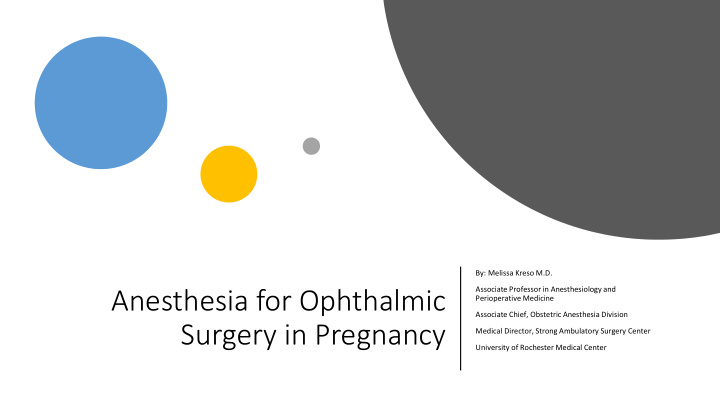



By: Melissa Kreso M.D. Associate Professor in Anesthesiology and Anesthesia for Ophthalmic Perioperative Medicine Associate Chief, Obstetric Anesthesia Division Surgery in Pregnancy Medical Director, Strong Ambulatory Surgery Center University of Rochester Medical Center
Disclosures None
Incidence Concerns with operating while pregnant Fetal Effects Outline Physiologic changes in pregnancy Practical Considerations
2% of pregnant women undergo surgery during pregnancy Incidence of 0.3-2.6% of women of childbearing age have positive UPTs on the day of surgery Pregnancy & Surgery All women of child-bearing age should have routine pregnancy testing prior to surgery Kahn RL, Stanton MA, Tong-Ngork S, et al. One-year experience with day-of-surgery pregnancy testing before elective orthopedic procedures. Anesth Analg 2008; 106:1127-31. Manley S, de Kelaita G, Joseph NJ, et al. Preoperative pregnancy testing in ambulatory surgery: incidence and impact of positive results. Anesthesiology 1995; 83:690-3. Kasliwal A, Farquharson RG. Pregnancy testing prior to sterilisation. BJOG 2000; 107:1407-9.
EARLY Concerns with Potential for altered operating organogenesis while pregnant Toxic manifestations
Organogenesis in Pregnancy Chestnut, David H. Chestnut's Obstetric Anesthesia: Principles and Practice . Philadelphia: Mosby/Elsevier, 2009: 17; p363 Figure 17.2 redrawn from Moor Kl. The Developing Human. 4 th Edition. Philadelphia WB Saunders 1993; 156.
Toxic manifestations Wilson JG. Environment and Birth defects New York, Academic Press, 1973:31. Chestnut, David H. Chestnut's Obstetric Anesthesia: Principles and Practice . Philadelphia: Mosby/Elsevier, 2009 : Chapter 17; p361.
EARLY Potential for altered organogenesis Concerns Toxic manifestations with operating LATER ON while pregnant Fetal hypoxia (as metabolic demands increase) Accidental induction of labor
Physiologic Changes in Pregnancy
Gastrointestinal Progesterone Anatomical effects Consider full Give bicitra stomach by prior to 18-20 weeks induction gestation Spalluto LB, Woodfield CA, Debenedectis CM, Lazarus E. “MR Imaging Evaluation of Abdominal Pain during Pregnancy:Appendicitis and Other Nonobstetric Causes” Radiographics2012; 32(2):317 -34.
Hematologic • Blood volume expands by 30-45% • Hypercoaguable state • WBC count is not a reliable marker for infection • Consider to be high risk for clotting postoperatively • Thromboembolism prophylaxis recommended Chestnut's Obstetric Anesthesia: Principles and Practice, 5th Edition (2014) Chestnut D, Wong C, Tsen L, Kee W, Beilin Y , Mhyre J/Elsevier Saunders. Chapter 2. p22
Respiratory Clinical Anesthesia, 8th Edition (2017) Barash P , Cullen B, Chestnut's Obstetric Anesthesia: Principles and Practice, 5th Edition (2014) Chestnut D, Stoelting R, Cahalan M, Stock M, Ortega R, Sharar S, Holt Wong C, Tsen L, Kee W, Beilin Y , Mhyre J/Elsevier Saunders. Chapter 2. p21 N/Wolters Kluwer Lippincott Williams and Wilkins Chapter 3. p376.
Airway • Weight gain • Capillary engorgement • Increased adipose tissue of the chest • mask ventilation & tracheal intubation difficulties Kodali BS, Chandrasekhar S, Bulich LN, Topulos GP , Datta S. Airway Changes during Labor and Delivery. Anesthesiology 2008; 108(3):357-62.
Cardiac Chestnut's Obstetric Anesthesia: Principles and Practice, 5th Edition (2014) Chestnut D, Wong C, Tsen L, Kee W, Beilin Y , Mhyre J/Elsevier Saunders. Chapter 2. p17
Cardiac Cardiac Heart Output Rate Stroke Volume Chestnut's Obstetric Anesthesia: Principles and Practice, 5th Edition (2014) Chestnut D, Wong C, Tsen L, Kee W, Beilin Y , Mhyre J/Elsevier Saunders. Chapter 2. p17
Aortocaval Compression Chestnut, David H. Chestnut's Obstetric Anesthesia: Principles and Practice . Philadelphia: Mosby/Elsevier, 2009: 2; p29. redrawn from Camann WR, Ostheimer GW. Physiologic adaptations during pregnancy. Int Anesthesiol Clin 1990;28:2-10.
Timing of Surgery However, IF surgery is indicated Elective surgery a parturient should should NOT be never be DENIED performed during said surgery on the pregnancy basis of being pregnant
1 st trimester - Organogenesis Increased fetal risk of teratogenicity & abortion 3 rd trimester - Peak of physiologic changes in Timing of pregnancy Surgery Increased maternal risk Increased risk of preterm labor 2 nd trimester is ideal time for non-emergent, essential surgeries
Incidence (%s) of Surgery in each Trimester Timing of Surgery 1st trimester 2nd Trimester 3rd Trimester Mazze RI, Källén B. Reproductive outcome after anesthesia and operation during pregnancy: a registry study of 5405 cases. Am J Obstet Gynecol. 1989 Nov; 161(5):1178-85.
Timing of Surgery Upadya M, Saneesh PJ. Anaesthesia for non-obstetric surgery during pregnancy. Indian J Anaesth 2016; 60(4):234-41
Needs to be done at a place that has both obstetric, neonatal & pediatrics services Where If patient’s obstetrician does not have privileges at should the institution, then an alternative obstetrician with privileges needs to be identified surgery take place? Qualified individual whom can interpret fetal heart monitoring strips needs to be readily available
If previable, ascertaining fetal heart tones via doppler preoperatively and postoperatively is sufficient Fetal Monitoring If viable, fetal heart rate monitoring should be done preoperatively & postoperatively BUT can be done intraoperatively as well Monicahealthcare.com
Fetal Monitoring • ACOG: • “decision to use [intraoperative] fetal monitoring should be individualized and, if used, should be based on gestational age, type of surgery, and facilities available”
General Anesthesia at +18-20weeks Viable agents reach Decreased albumin Unconsciousness will Quicker inductions equilibrium faster due causes low protein happen quicker and Decreased MAC occurs occur inhalationally to increased alveolar binding --> increased more unexpectedly (by 30-40%) and parenterally hyperventilation and free fraction of drugs with sedation decreased FRC into the blood stream medications
Full Stomach Precautions at +18-20 weeks After 18-20 weeks Administer bicitra RSI with/without gestation, consider (nonparticulate cricoid full stomach antacid) 30ml
Thiopental Propofol Drugs with a history of Morphine/fentanyl safety Succinylcholine behind them Nondepolarizing muscle relaxants Nitrous oxide (particularly after the 6 th week of gestation)
Glycopyrrolate (too big) Succinylcholine (too ionized) Drugs that Insulin ( too big) do not cross the placenta Heparin ( too big) All non depolarizing muscle relaxants ( too big)
Recommend
More recommend